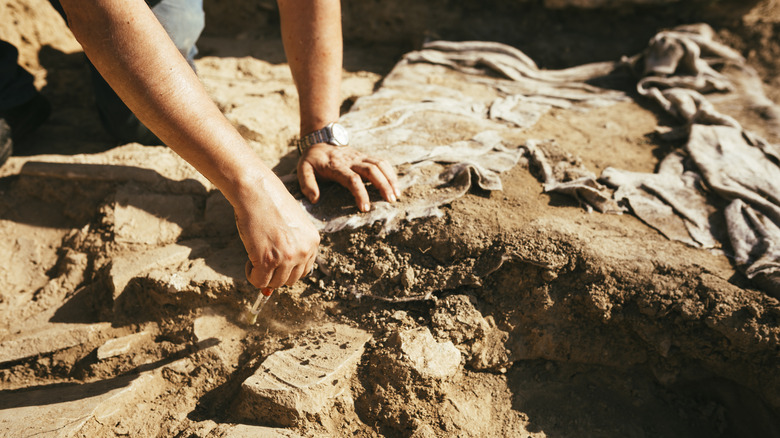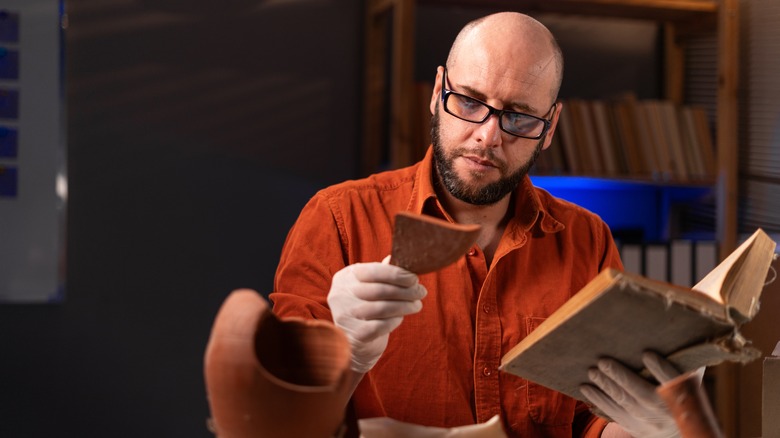The Rare Artifact That Was The First Of Its Kind To Be Found In Scotland
Sometimes the most mind-blowing archaeological discoveries are found by mistake. In 1799, French soldiers stumbled upon the Rosetta Stone, an ancient Egyptian black granite stone etched with inscriptions that led to a better understanding of hieroglyphics. The Dead Sea Scrolls were accidentally discovered in 1947 by a shepherd who tossed a rock into a cave, breaking the ancient pottery that hid them. More recently, in 2025, archaeologists in Scotland unintentionally unearthed ancient artifacts dating back over 2,000 years.
As crews prepared a 123-acre development to make way for a new golf course in the Scottish Highlands near Inverness, the excavation of an ancient wheel set things into motion. At first, archaeologists believed they had turned up an old piece of farm equipment. Upon further inspection, they identified the artifact as an Iron Age chariot wheel, culminating in one of the most amazing historical discoveries of the year.
The wheel deal
Similar archaeological finds have been made in nearby countries, such as the unearthing of a treasure trove of over 800 Iron Age artifacts buried in Northern England. But the discovery of the chariot wheel marked the first of its kind in the Scottish Highlands. Principal archaeologist at Avon Archaeology Highland, Andy Young, expressed his team's initial bemusement to BBC Scotland News. "None of us had really seen [a chariot wheel] before in terms of physically excavating one," he said. The wheel is one of five chariot artifacts discovered in all of Scotland. "They are such a rare thing," Young noted.
Young estimates that the wheel dates back to around 200 B.C., making it about 2,200 years old. Of course, the impending results of radiocarbon testing will give archaeologists a more definitive idea of when the wheel first turned. What archaeologists know without such analysis is that the artifact is made of iron and appears to have been buried in a pit along with the cremated remains of a human, pottery, and animal bones. Young further deduces that the wheel was likely crafted by a highly skilled blacksmith, which would have been expensive back in the day, telling Smithsonian Magazine that the person buried in the pit was probably someone "pretty important."
A treasure trove of artifacts
The chariot wasn't the only relic archaeologists dug up. The other unearthed objects included flint tools, ancient pottery, a 3,500-year-old cremation urn from the Bronze Age, and at least 25 Neolithic wooden buildings. They also uncovered grain-drying kilns and signs of medieval field systems, dating the hallowed ground as far back as 6,000 years to the Middle Ages.
"This has been a remarkable journey from prehistoric times to the present, right here on our doorstep," Stuart McColm, vice president of golf development at Cabot Highlands, told The Scotland Sun. "It's humbling to think that our new championship course, Old Petty, will rest on such historically rich ground."
The Old Petty golf course is scheduled for a soft opening between August 1 and September 30 of 2025, with its grand opening slated for spring of 2026. As for the ancient artifacts, the results of radiocarbon testing are expected by the end of 2025, which will, in theory, paint a clearer picture of their history. After being submitted to Treasure Trove Scotland — a system that allocates artifacts to museums across the country — they will likely be displayed at the National Museum of Scotland or the Inverness Museum near the site they were found.


